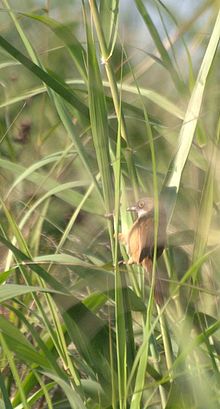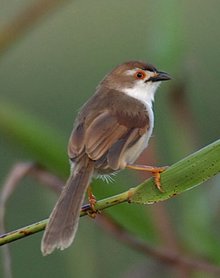- Jerdon's Babbler
-
Jerdon's "Babbler" 
Conservation status Scientific classification Kingdom: Animalia Phylum: Chordata Class: Aves Order: Passeriformes Family: Sylviidae Genus: Chrysomma Species: C. altirostre Binomial name Chrysomma altirostre
Jerdon, 1862Synonyms Moupinia altirostris
Pyctorhis altirostris
Pyctorhis griseigularis
Timalia altirostrisJerdon's Babbler (Chrysomma altirostre) is an endangered passerine bird from South Asia. Formerly placed in the Timaliidae family – hence the common name "babbler" –, the genus Chrysomma and its relatives are actually closer to the typical warblers and parrotbills in the Sylviidae.[1]
Contents
Description
Measuring 16–17 cm in length, it is quite intermediate in habitus between certain typical warblers (Sylvia) and the parrotbills (Paradoxornis). Like these, it is a drab bird with a long tail used to balance when creeping through the vegetation; its bill is thicker than in Sylvia but not as heavy as in Paradoxornis. Buffy chestnut brown above and a slightly lighter yellowish-brown on the belly, its lores are pale greyish, as are the throat and breast. The tail and a wing patch are redder than the rest of the upperside. The legs and feet are dark, the bill is greyish-horn colored above and pale below; the eyes' irides are yellowish-brown and a thin nude ring of greenish-yellow skin surrounds the eye.[2]
The sexes are alike; young birds have a more orange hue to the upperside plumage, and the lower bill is pink. Differences between subspecies are slight, with the central population essentially have richer chestnut brown and darker grey colours.[3]
Its relative, the Yellow-eyed "Babbler" (C. sinense), looks like a brighter version of the same but has somewhat more vivid colors, with white replacing grey in the plumage, an additional white supercilium, yellowish legs, feet and irides, and an orange-yellow eye-ring.[2]
The song is a weak 4- to 8-note warbling chi-chi-chi-chew-chew-chew, tew-tew-tew-tew chew or ih-ih-ih-ih chew chitit chew i'wwiuu, with a drawn-out end note and sometimes starting with a chatter of itch, itit or tchew. Birds sing usually in the early morning and in the evening, perching upright on a reed, with the head slightly elevated. Calls include a short tic or tsik, sometimes extended into a series ts-ts-tsik which may end in a plaintinve tew.[2]
Subspecies and range
Three subspecies are recognized, based mainly on their allopatric ranges:[3]
Myanmar Jerdon's "Babbler
Chrysomma altirostre altirostre Jerdon 1862
- Described above.
- Floodplains of the Irrawaddy River from Bhamo to Bago and up the Sittaung River nearly to Taungoo in Myanmar. Possibly extinct. The type specimen of the nominate subspecies – and thus the entire species – was collected on an island in the Ayeyarwady off Thayetmyo.
Terai Jerdon's Babbler
Chrysomma altirostre griseigularis
- Darker and richer in colour overall, more reddish above, lores blackish. Stronger grey hue on throat and breast.
- Sub-Himalayan Terai, from western Nepal and perhaps Bhutan to the Dooars and Brahmaputra floodplain of India, Cachar and the Naga Hills; possibly also the Surma River valley and Haor basin in Bangladesh, where it used to occur. A NHM specimen is supposedly from Bhamo in the Kachin State of Myanmar, but may just as well be mislabelled.
- The Sukla Phanta Wildlife Reserve in Nepal represents the western limit of its distribution.[4]
Sind Jerdon's Babbler
Chrysomma altirostre scindicum
- Resembles altirostre.
- Indus basin of Pakistan, where recorded from a few disjunct areas:
- Sanghar, Tharparkar and Umerkot Districts[verification needed] of SE Sindh Province. Population possibly extinct.
- Dadu, Khairpur, Larkana, Shaheed Benazeerabad District, Shikarpur and Sukkur Districts of NC Sindh Province, approximately from Sukkur (where the type specimen of scindicum was collected) to Nawabshah.
- Dera Ghazi Khan, Dera Ismail Khan, Mianwali and Muzaffargarh Districts between S North-West Frontier and SW Punjab Provinces. Old records specifically from near Bhamb, Jampur and Khanwah. Recent records exist from the Dera Ismail Khan area, Dhap Shumali, Taunsa Barrage and Chashma Barrage (the northernmost known site for this subspecies)
Ecology
It is presumably an all-year resident and inhabits dense growth near water, often in the floodplains and around oxbow lakes. Pairs or families of these birds, occasionally small flocks of 1-2 dozen, move about quietly in dense stands of grasses and reeds that grow several meters high, usually avoiding lower growth and shrubland. A typical foraging technique involves perching nearly horizontally on a reed stem, picking up a leaf sheath with the bill, and quickly tearing off the leaf and its base sheet to expose small arthropods and other invertebrates. The tearing of dry leaves produces a subdued crackling sound that can sometimes be heard from some dozens of meters away.[3]
Plants dominating its favorite habitat are typically tall reeds several meters in height. C. a. scindicum is usually found in association with Hardy Sugarcane (S. arundinaceum) and Kans Grass (S. spontaneum), while C. a. griseigularis is also found in Munja (S. munja[verification needed]) stands, and in the east of its range in Ravennagrass (S. ravennae) and perhaps S. procerum. Prime habitat also contains a generous amount of Common Reed (Phragmites australis) or Khagra Reed (P. karka), as well as Typha reedmaces (e.g. Typha angusta). On the other hand, sugarcane plantings or other single-species reedbeds as well as lower growth are not very attractive to the species. Other plants, typically grasses, are found to a lesser extent in the bird's haunts. They include such species as satintails (Imperata, e.g. Cogongrass I. cylindrica), Giant Cane (Arundo donax), Vetiver or khus (Cymbopogon zizanioides), Desmostachya bipinnata, Narenga porphyrocoma and Themeda arundinacea.[3]
Conservation status
It is classified as Vulnerable by the IUCN, being nowhere common and at least in Assam (where it is perhaps most numerous) its numbers are declining. The nominate subspecies from Myanmar might be extinct already. It was last seen in July 1941 in habitat fragments at Myitkyo, with the last specimen taken in 1914 or perhaps as late as the mid-1930s. Due to the inaccessibility of its range and consequent lack of fieldwork, it might conceivably still exist however. Likewise, the continuing existence of this species in Bangladesh is uncertain. The subspecies griseigularis is the only one known to occur in protected areas, namely the Dibru-Saikhowa, Kaziranga and Manas National Parks in Assam, and the Chitwan National Park and Sukla Phanta Wildlife Reserve of Nepal. Its presence in the latter country was not documented until 1989/1990. Subspecies scindicum is known to be rare and has been declining throughout recent decades. At present, the only place where it is seen fairly often is the Rohri Canal south of Khairpur.[5]
Altogether, less than 10,000 adult birds are believed to remain. Its threat category is VU A2c+3c+4c. This means that its population has declined by an estimated 30% and is expected to continue to do so for another decade at least. The reasons are not fully understood, but the population reduction is probably related to habitat destruction by drainage and damming of wetlands for agriculture and flood control, and these threats are not expected to cease anytime soon. In 1933 it was stated that to attract the birds there ought to be
"... a regular 'sea of sugarcane', preferably not less than six feet[verification needed] high."[6]
but in our time, such habitat is extremely rare.[7]
Sustainable cutting of reedbeds, which yield material for human use, is apparently tolerated by C. altirostre. Large flocks of the species are found in partially cut or burned reedbeds, thus if large-scale clear-cutting is avoided, human use of reeds may in fact improve habitat quality by preventing the simultaneous aging and decay of wide stretches of habitat. As a rule-of-thumb, as long as a healthy population of Phragmites reeds persists, the birds are likely to persist too.[6]
Footnotes
- ^ Jønsson & Fjeldså (2006), Collar & Robson (2007), BLI (2008, 2009)
- ^ a b c Baral & Eames (1991), BLI (2009)
- ^ a b c d Baral & Eames (1991), Showler & Davidson (1999), BLI (2009)
- ^ Baral, H.S., Inskipp, C. (2009) The Birds of Sukla Phanta Wildlife Reserve, Nepal. Our Nature (2009) 7: 56-81 download pdf
- ^ Baral & Eames (1991), Showler & Davidson (1999), Collar et al. (2001), BLI (2008, 2009)
- ^ a b Showler & Davidson (1999)
- ^ Showler & Davidson (1999), BLI (2008, 2009)
References
- Baral, H.S. & Eames, J.C. (1991): Jerdon's Babbler Moupinia altirostris: a new species for Nepal. Forktail 6: 85-87. PDF fulltext
- Baral, H.S. & Inskipp, C. (2009): The Birds of Sukla Phanta Wildlife Reserve, Nepal. Our Nat. 7: 56-81. PDF fulltext
- BirdLife International (BLI) (2008). Chrysomma altirostre. In: IUCN 2008. IUCN Red List of Threatened Species. Downloaded on 20 May 2009.
- BirdLife International (BLI) (2009): Species factsheet: Chrysomma altirostre. Retrieved 2009-MAY-20.
- Collar, Nigel J.; Andreev, A.V.; Chan, S.; Crosby, M.J.; Subramanya, S. & Tobias, J.A. (eds.) (2001) Chrysomma altirostre In: Threatened Birds of Asia: The BirdLife International Red Data Book: 2112-2119. BirdLife International. ISBN 0946888442
- Collar, Nigel J. & Robson, C. (2007) Family Timaliidae (Babblers). In: del Hoyo, Josep; Elliott, Andrew & Christie, D. (eds.) Handbook of the Birds of the World (Vol. 12: Picathartes to Tits and Chickadees): 70-291[verification needed]. Lynx Edicions, Barcelona. ISBN 9788496553422
- Jønsson, Knud A. & Fjeldså, Jon (2006) A phylogenetic supertree of oscine passerine birds (Aves: Passeri). Zool. Scripta 35(2): 149–186. doi::10.1111/j.1463-6409.2006.00221.x (HTML abstract)
- Showler, D.A. & Davidson, P. (1999) Observations of Jerdon's Babbler Chrysomma altirostre and Rufous-vented Prinia Prinia burnesii in Punjab and North-West Frontier Provinces, Pakistan. Forktail 15: 66-76. PDF fulltext
Categories:- IUCN Red List vulnerable species
- Chrysomma
- Old World babblers
- Birds of India
Wikimedia Foundation. 2010.


